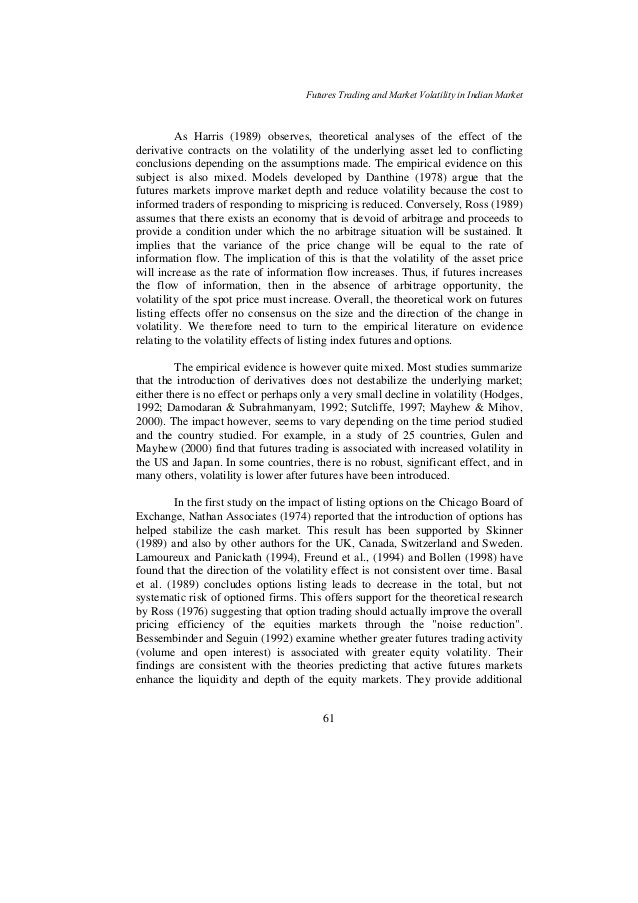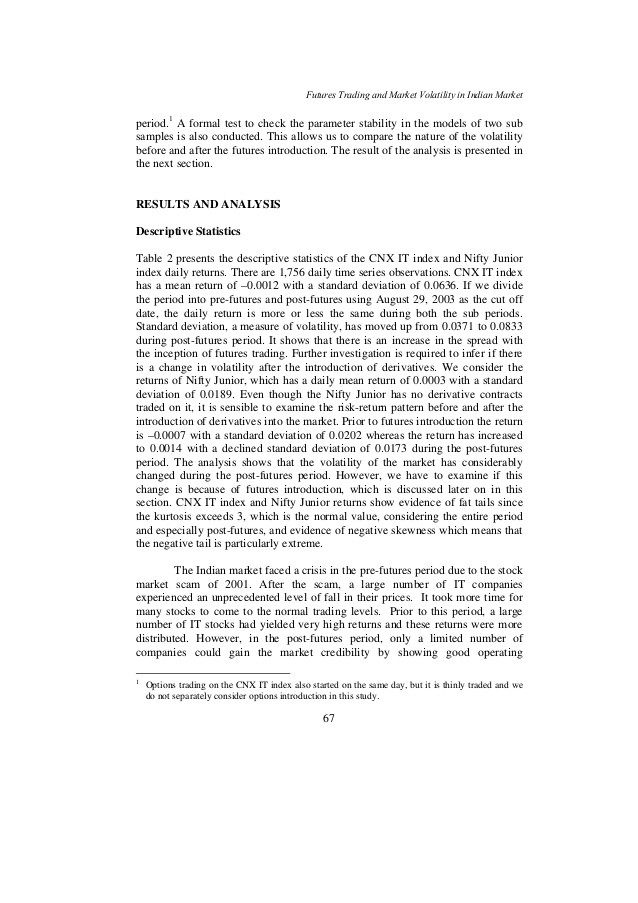Mispricing Volume Volatility and Open InterestEvidence from Indian Futures Market
Post on: 26 Май, 2015 No Comment

Page 1
emf.sagepub.com/
Journal of Emerging Market Finance
emf.sagepub.com/content/7/3/263
The online version of this article can be found at:
Mispricing, Volume, Volatility
and Open Interest: Evidence
from Indian Futures Market
Vipul
Interdependence of the mispricing, volatility, volume and open interest of stock
futures and the volatility and volume of their underlying shares is examined in a
vector autoregressive framework. There is evidence of signifi cant mispricing that
persists for one day but is not explained by other variables. An increase in the
volatility of futures is generally followed by an increase in the volatility of the
underlying. The volatility and volume of futures and the underlying exhibit alter-
nating increase/decrease cycles with up to fi ve-day lags. These properties can be very
useful in forecasting the mispricing and the volatility, volume and open interest for
futures and their underlying shares. Futures mispricing does not change fi nancial
activities in any predictable manner.
JEL Classifi cation: G13
Keywords: Stock futures, mispricing, volatility, volume, open interest, VAR
1. Introduction
According to the ‘no arbitrage’ argument, the futures price should be the
price of the underlying (adjusted for the present value of the known future
cash infl ows) plus the cost of carry. If the actual futures price differs from this
264 / Vipul
Journal of Emerging Market Finance, 7:3 (2008): 263–92
stock futures and their underlying shares. Mispricing of futures has important
implications for both hedgers and arbitrageurs. Whereas it makes hedging less
effective, it also provides profi t opportunities to the arbitrageurs. Therefore,
if the patterns of the occurrence and persistence of mispricing could be
discerned, it would greatly benefi t many market players. The mispricing of
stock index futures has been investigated in a number of studies in the past.
Individual stock futures have not been researched adequately because of
their recent introduction to the fi nancial markets. The present study extends
literature to bridge this gap. It is particularly useful because arbitrage is
relatively easier to set up for the stock futures (which have a single underlying
asset) as compared to the stock index futures.
Modest and Sundaresan (1983), Figlewski (1984), MacKinlay and
Ramaswamy (1988) and Yadav and Pope (1994) found signifi cant incon-
sistencies between the spot prices and the futures prices for stock indexes
which can be exploited by arbitrageurs. They also reported that the magnitude
of mispricing was greater during the periods when the implied volatility was
higher. An autocorrelated persistent mispricing between the spot and futures
prices was observed by MacKinlay and Ramaswamy (1988), Neal (1990),
Chung (1991) and other researchers in the US; Yadav and Pope (1994) and
Garrett and Taylor (2001) in the UK; Bowers and Twite (1985), Heaney
(1995) and Brailsford and Hodgson (1997) in Australia; Brenner et al. (1989)
in Japan; Lai and Marshall (2002) in Hong Kong; Puttonen (1993a and b) in
Finland; and Vipul (2004) in India. One plausible reason for this behaviour
was given as non-synchronous trading in the stock and futures markets.
However, subsequent research based on high frequency data, which controls
the non-synchronous error, still confi rmed numerous instances of mispricing
providing an opportunity of arbitrage (see MacKinlay and Ramaswamy 1988;
Brennan and Schwartz 1990; Hodgson et al. 1993; Yadav and Pope 1994).
Chung (1991), Klemkosky and Lee (1991), Miller et al. (1994), Butterworth
Page 4
Mispricing, Volume, Volatility and Open Interest / 265
Journal of Emerging Market Finance, 7:3 (2008): 263–92
with the fi ndings of Chen et al. (1995) and Chan and Chung (1993) for
stock index futures in the US, they found that the increased volatility
reduces mispricing. They did not fi nd a direct effect of the volatility on the
open interest. However, open interest rose for three days after a shock in the
pricing error. Chan and Chung (1993) found that prior to this phenomenon
an increase in the arbitrage spread leads to signifi cant increases in the cash
trading volume and the cash and futures price volatility. However, short sale
restrictions in the cash market attenuated this relationship. Brailsford and
Hodgson (1997) confi rmed a signifi cant effect of the volatility and trading
volume on the mispricing in Australia. Theobald and Yallup (1996) found
the mispricing to have an inverse relationship with the volatility but a positive
relationship with the trading volume for the UK stock index futures market.
Hemler and Longstaff (1991) and Merrick (1987) did not fi nd a signifi cant
relationship between the volatility and the mispricing. This leaves us with
mixed evidence about the relationship between mispricing, volatility, trading
volume and open interest in different markets and contexts.
To summarise, the mispricing in stock index futures is found to be closely
related to market activities refl ected in the volatility and volume of the futures

and their underlying. Some researchers fi nd that a higher volatility, due to its
associated violent movements of prices, leads to more mismatches between
the futures and their underlying and therefore, a higher mispricing. Others
fi nd that a higher volatility signifi es more activity which includes arbitrage
and therefore, leads to reduced mispricing. Higher volumes that refl ect
more activity in the market would lead to reduced mispricing. On the other
hand, if the volumes are driven by some speculative motive, then the higher
volumes would be associated with higher mispricing. Open interest being
directly related to the depth of the futures market also refl ects the activity
level and therefore, is expected to be linked to mispricing. These aspects have
been empirically investigated in the context of index futures but need to be
266 / Vipul
Journal of Emerging Market Finance, 7:3 (2008): 263–92
the futures based on a single share, the mispricing of stock futures provides
a good insight into the economic forces behind the pricing of futures. Stock
futures were introduced to derivatives markets quite recently all over the
world, and are not very liquid in many markets. This is one of the reasons
for the lack of research work in this area. Fortunately, in India this is not the
case. Stock futures, which were introduced in November 2001, have been
more popular than the options and index futures and are highly liquid. The
price discovery of futures can, therefore, be considered fairly effi cient. In
view of these facts, the Indian market provides a good opportunity to study
the mispricing of stock futures.
2. Futures Contracts in India
Futures were introduced to the Indian market in June 2000 when both the
National Stock Exchange (NSE) and the Stock Exchange, Mumbai (BSE)
started trading in index futures. Even earlier the Indian stock market was
accustomed to carry forward facilities (badla system) that had some charac-
teristics of futures contracts. Whereas NSE started with the trading of futures
on S&P CNX NIFTY Index, BSE introduced futures on the Sensex. The
average daily volume of trading in options and futures picked up from
Rs 20 million (about US$ 0.46 million) in June 2000 to cross Rs 87.90 bil-
lion (about US$ 2.04 billion) by November 2004 at NSE. Stock futures
were introduced in November 2001 by NSE and BSE on 41 equity shares.
NSE accounts for more than 97 per cent of the total turnover in the index
and stock-based derivative products in India. Stock futures are relatively
recent entrants to derivatives markets globally and have not attracted much
research interest. In fact the Indian derivatives market has been one of the
pioneers in stock futures. The NSE traded six most liquid stock futures are














